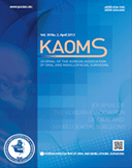Journal of the Korean Association of Oral and Maxillofacial Surgeons
- P-ISSN2234-7550
- E-ISSN2234-5930
- SCOPUS, KCI, ESCI
 ISSN : 2234-7550
ISSN : 2234-7550
An experimental investigation of the effects of chronic stress on bone-to-implant contact
Alihan Bozoglan (Department of Periodontology, Faculty of Dentistry, Firat University, Elazig)
Ferhan Yaman (Private Practice, Oral and Maxillofacial Surgeon, Diyarbakir, Turkey)
Mustafa Kirtay (Private Practice, Oral and Maxillofacial Surgeon, Toronto, Canada)
Ozgur Bulmus (Department of Physiology, Faculty of Medicine, Firat University, Elazig)
Hacer Sahin Aydinyurt (Department of Periodontology, Faculty of Dentistry, Yüzüncü Yıl University, Van)
Murat Yavuz Solmaz (Department of Mechanical Engineering, Faculty of Engineering, Firat University, Elazig, Turkey)
Cenk Yanen (Department of Mechanical Engineering, Faculty of Engineering, Firat University, Elazig, Turkey)
Abstract
Objectives: This study aimed to investigate the effects of chronic restraint stress on the osseointegration of titanium implants. Materials and Methods: Twenty adult male Wistar albino rats were used in the study. After surgical insertion of titanium implants into the metaphyseal part of the tibial bone, rats were randomly divided into two groups: a control group (CNT group) and an experimental restraint stress group (RS group). In the CNT group, titanium implants were inserted surgically, and rats received no further treatment during the 47-day experimental period. In the RS group, restraint stress was applied for 3 hours per day for 45 days, beginning 2 days after implant surgery. Weight of the rats was measured prior to surgery and at the end of the study to analyze the effects of stress. At the end of the experimental period, rats were euthanized, and implants and surrounding bone tissues were used for undecalcified histological analysis. Serum cortisol levels were assessed in cardiac blood samples from the rats following centrifugation. Results: Average weight of rats in the RS group was lower than that of rats in the CNT group after the experimental protocol had been completed (P<0.05). Further, serum cortisol levels were higher in the RS group than in the CNT group (P<0.05). There were no significant differences in bone-implant connection levels between the two groups (P>0.05). Conclusion: The data analyzed in this study suggest that chronic restraint stress did not adversely affect rats during a 45-day osseointegration period.
- keywords
- Restraint stress, Osseointegration, Bone-to-implant contact, Rats, Tibia
- 다운로드 수
- 조회수
- 0KCI 피인용수
- 0WOS 피인용수